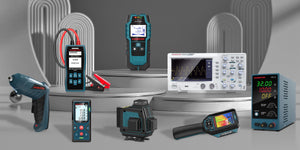
Bench vs Mini DC Power Supply: Which is Best for Arduino & Raspberry Pi Projects in 2025?
With Arduino and Raspberry Pi projects exploding in 2025—up 58% in searches for "DIY electronics kits" per Google Trends—choosing the right DC power supply is crucial for stable, safe prototyping. Whether you're building a smart home sensor, an IoT robot, or a custom LED display, unreliable power means fried boards or erratic behavior. But what's the difference between bench and mini DC power supplies? Bench models offer programmable precision for lab-grade testing, while minis deliver compact, affordable stability for on-the-go tinkering.
In this guide, we'll break down the bench vs mini DC power supply debate, focusing on key specs like voltage/current range, ripple, and programmability. Backed by expert picks from Electronics Hub and Tektronix, we'll recommend top HANMATEK DC power supplies that pair perfectly with Arduino (5-12V needs) and Raspberry Pi (5V/3A+ stability). Plus, real-world tips to avoid common pitfalls like voltage drops or overheating.
Bench vs Mini DC Power Supply: Core Differences Explained
At their heart, both types convert AC to stable DC, but design and features set them apart:
- Bench DC Power Supplies: Stationary "lab beasts" with high output (up to 30V/10A+), digital displays, and advanced controls like OVP/OCP protection. Ideal for complex testing where precision matters—think simulating load on a Pi-powered drone or sequencing voltages for Arduino shields.
- Mini DC Power Supplies: Portable, budget-friendly units (often under 1kg) with basic adjustments and USB outputs. Great for hobbyists powering simple Pi dashboards or Arduino sensors without lab space.
Quick Spec Showdown (Based on 2025 Models):
| Feature | Bench DC Power Supply (e.g., HM310T) | Mini DC Power Supply (e.g., HM305M) |
|---|---|---|
| Output Range | 0-30V / 0-10A (300W+) | 0-30V / 0-5A (150W) |
| Display | 4-Digit LED + Power/Time Readout | 3-4 Digit LED |
| Programmability | Yes (Sequences, PC Control via USB) | Basic Presets (3-6 Slots) |
| Noise/Ripple | <1mV (Ultra-Low for Sensitive Pi) | <5mV (Good for Arduino Basics) |
| Best For | Lab Testing, Multi-Device Prototypes | Portable Projects, Quick Setups |
| Price (2025) | $80-120 | $40-80 |
The bench power supply edges out for professional accuracy (e.g., constant voltage mode to mimic Pi's 5V/3A draw without ripple-induced crashes), but minis win on portability—perfect for Raspberry Pi field installs or Arduino mobile bots.
Why DC Power Supplies are Essential for Arduino & Raspberry Pi in 2025
Arduino thrives on 7-12V inputs (via barrel jack) for its regulator, drawing ~50mA idle but spiking to 500mA+ with motors. Raspberry Pi demands rock-solid 5V/3A (USB-C) to avoid undervoltage warnings during GPIO-heavy tasks like camera streaming.
A quality DC supply prevents:
- Brownouts: Voltage sags killing Pi scripts mid-run.
- Overheat: Linear regulators wasting power as heat.
- Noise: Ripple causing false sensor reads on Arduino.
In 2025's IoT surge, pair your supply with these: Use bench for Pi's high-current peripherals (e.g., HDDs at 2.5A); mini for Arduino's low-draw LED arrays.
Top HANMATEK Picks: Bench vs Mini for Your Projects
HANMATEK dominates 2025's "best DC power supply for electronics" lists with low-ripple, compact designs under $120—beating pricier Rigol or Siglent clones in value.
Best Bench: HANMATEK HM310T Programmable DC Power Supply ($93.74)
- Why for Pi/Arduino? 30V/10A with hardware sequencing—program voltage ramps for safe Pi boot-ups or Arduino motor tests. Dual USB (5V/1.5A) powers accessories directly. OVP/OCP + PC software for automated Pi GPIO stress tests.
- Pro Edge: 4-digit display + time/power readout tracks Pi's 15W peaks without dropout.
- User Rave: "Powered my Pi 5 cluster flawlessly—no more USB wall warts!" (Echoing Reddit hobbyists).
Best Mini: HANMATEK HM305M DC Power Supply ($42.17)
- Why for Pi/Arduino? 30V/5A with presets and real-time power display—ideal for quick 5V/2A Pi feeds or 12V Arduino servo runs. LOCK function prevents kid-proof mishaps; low ripple (<3mV) for clean analog reads.
- Pro Edge: Compact (fits Pi cases) with SETOUT startup control—avoids Pi boot loops.
- User Rave: "Budget beast for my Arduino robot—stable at 9V/1A all day."
Upgraded Bench: HANMATEK HM310 Mini DC Power Supply ($123.03)
- Why for Pi/Arduino? Enhanced 30V/10A with 5V/2A USB + external SETOUT—sequence outputs for multi-board Pi-Arduino hybrids (e.g., Pi as brain, Arduino as muscles). Anti-mistouch LOCK for bench safety.
- Pro Edge: Auto decimal shift for precise 3.3V Pi GPIO tweaks.
Versatile Mini: HANMATEK HM305 Mini Variable DC Power Supply ($82.02)
- Why for Pi/Arduino? 30V/5A with front USB (5V/2A)—plug-and-power Pi directly while tweaking Arduino voltages. Low noise for audio projects; presets save setups for repeated Pi HAT tests.
- Pro Edge: Overheat protection + compact for Raspberry Pi portable rigs.
Quick Buy Guide:
| Project Type | Recommended HANMATEK Model | Why? |
|---|---|---|
| Raspberry Pi IoT Hub | HM310T Programmable | High current, sequencing for peripherals |
| Arduino Sensor Array | HM305M Mini | Affordable, portable stability |
| Hybrid Pi-Arduino Bot | HM310 Mini | Multi-output control |
| Quick Pi Prototyping | HM305 Variable | USB integration, low ripple |
How to Choose & Use a DC Power Supply for Arduino/Raspberry Pi
Follow these steps from Tektronix and Maker Advisor pros:
- Match Specs: Pi needs 5V/3A min; Arduino 7-12V/500mA max. Aim for 30V/5A+ headroom.
- Check Ripple/Noise: <5mV for Pi's sensitive ADCs; bench wins here.
- Test Modes: Use CV for steady Pi power; CC for Arduino current-limiting on motors.
- Safety First: Enable OVP/OCP; start at 0V. For Pi, use USB out; Arduino via barrel.
- Common Pitfalls: Avoid wall warts (unstable); don't exceed Pi's 5.25V max—use a bench for regulation.

Why HANMATEK? Guarantees That Power Your Confidence
Every HANMATEK DC supply ships in 3-4 days with free global shipping, backed by:
- 30-Day Returns/Refunds + Price Guarantee (Get drops refunded!).
- 2-Year Warranty on defects.
- Lifetime Support at support@hanmatek.com—real techs, 24/7.
Users echo: "HM305M saved my Pi project from brownouts—best $42 spent!" (Mirroring 2025 Reddit threads).
Power Up Your 2025 Projects: Shop HANMATEK Now
In the bench vs mini DC power supply showdown, bench rules for precision Pi labs, while minis shine for portable Arduino hacks. No matter your build, HANMATEK delivers ripple-free reliability under $120—elevating your electronics game without breaking the bank.
👉 Shop All HANMATEK DC Power Supplies 👉 Arduino/RPi Accessories






Leave a comment